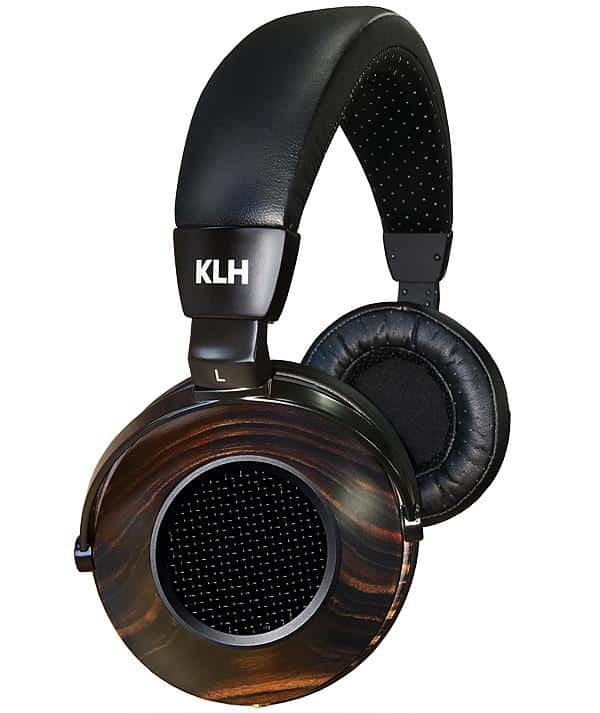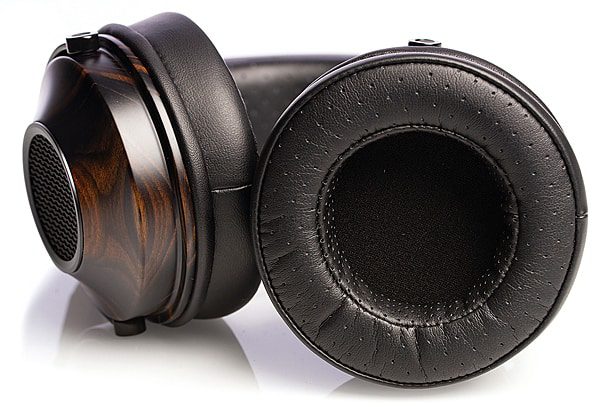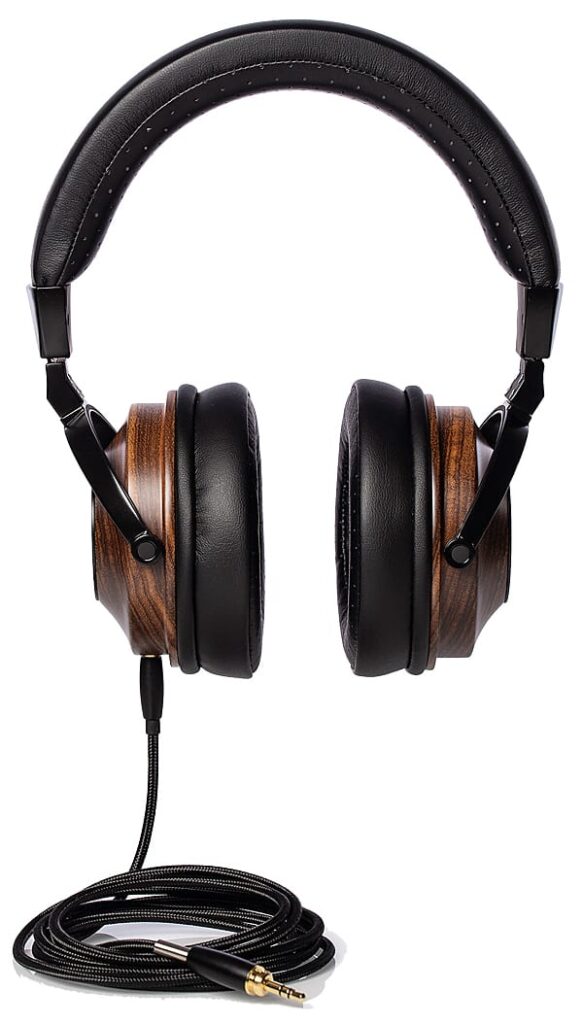KLH Ultimate One Headphones hi-fi News
April 16, 2021


Beryllium drivers, sustainable hardwood, real leathers, price – these debut open-back ‘phones tick all the boxes. But do they offer the ultimate in sound quality?
Mention beryllium and digit counters begin to whorl in the imagination. Unquestionably the very best metal from which to construct a headphone or loudspeaker diaphragm – because the speed of sound through it is over twice that of aluminium, magnesium or titanium – its use has historically been constrained for two reasons. First, beryllium is dangerous stuff to use in a manufacturing environment; and second, it’s expensive. For proof of the latter look around you at, say, TAD’s loudspeakers or Focal’s Utopia [HFN Feb ’17] and Stellia [HFN May ’19] headphones. The Focals, both equipped with drivers having beryllium diaphragms, cost about £3500 and £2800 respectively.
So the arrival of the KLH Ultimate One is an eyebrow raiser for two reasons. One, it marks the unexpected renaissance of a famous audiophile name, albeit one best known for electrostatic speakers. And two, it uses 50mm ‘pure beryllium’ drivers while asking just £300 of you – not as a first payment on the never-never, but as the full cost of ownership.
Silver Service
Beryllium isn’t the only costly feature that the Ultimate One boasts, either – its cable uses silver Litz conductors, with individually insulated silver strands. How does KLH do it at the price? Part of the answer must lie with the Ultimate One being made in China, although that is hardly unusual.
Construction of the Ultimate One is otherwise pretty conventional, with circular capsules having deep circular earpads with lambskin on the inner surfaces for comfort and cowhide externally for durability. The real wood earcups are available in either ebony, which KLH says is sustainable, or zebra wood. The latter costs extra and is available as a special order.


Comfort is pretty good. The headset weights 349g (measured, 340g specified) which isn’t featherweight but less than that of many audiophile headphones, planar magnetics in particular. The clamping force is low at 4.1N for a 150mm head width and the headband is sufficiently well padded not to chafe on the pate. What lets the side down a little – although the same can be said of countless other headphones – is the circular earpads that, although thick and squishy, are sufficiently small not just to press against the earlobes: the tips of mine poked outside them. Having experienced a number of headphones recently that have ovoid earpads to accommodate the outer ear more naturally, I find this pinna assault increasingly annoying.
On the face of it the Ultimate One might appear quite well adapted to use on the move. As well as being fairly light, it has capsules that rotate sufficiently for it to lie flat within the supplied zip-up hardshell case. A cloth drawstring carry bag is also provided should the case be too bulky. But this is another headphone that appears rather schizoid in this regard because its 2m cable, terminated in TRS mini-jack plugs at both ends, is manifestly too long for use on the hoof, just as it’s shorter than ideal for use with a conventional hi-fi system (for which a screw-on sleeve adapter is provided to convert the input connector to a ¼in jack). Also, there’s no mic or in-line remote control to enhance convenience when the headphones are used with a smartphone.
Well Damped
Expecting all this and beryllium diaphragms for £300 may be a case of asking too much, of course, but I suspect many Ultimate One owners will swap out the supplied cable in frustration for something of more convenient length – either shorter or longer – but not with the standard cable’s silver Litz conductors, which seems a shame.
One positive about the cable is that – despite a braided sheath – it does not generate high levels of capsule noise when it rubs against clothing or furniture. This may well have something to do with the Ultimate One’s structure being well damped at high frequencies but there is evidence – subjective and objective – of headband resonance at lower frequencies. This is at a sufficiently low level that there’s no obvious coloration of pink noise played over one capsule only, but some carry-over of sound towards the inactive capsule can still be heard. Measurement confirms that the headband does resonate at low frequencies, most obviously when it is lifted off the artificial head. The dip in response at 60Hz appears to be associated with one of these resonances, as does the response glitch just above 1kHz.
Arguably more serious in practice is that the Ultimate One is slightly sensitive to the integrity of its earpad seal. This is normal for closed-back designs but open-backs like the KLH tend to form two distinct groups: those that are substantially unaffected by a compromised earpad seal, and those that are sensitive to it. Of recently measured open-backs the Quad ERA-1 [HFN Aug ’18], Meze Empyrean [HFN Dec ’18] and HiFiMan Arya [HFNAug ’19] are all in the first group, whereas the MrSpeakers Ether 2 [HFN Jul ’19] and the Ultimate One fall into the latter. The Ultimate One is a good deal less sensitive to leakage past spectacles or though hair than the Ether 2, but its bass/lower-mid tonal balance may nonetheless change from user to user.
![]()
![]()
The first thing I discovered when donning the Ultimate Ones [writes CB] was, due to their low clamping force, they tended to slide forwards (or off) if I looked down – eg, standing up to change a disc. No means a deal-breaker, but something to remember. But on to the listening! For high-res files I used a Mytek Brooklyn DAC/amp [HFN Aug ’17] with my Macbook Pro running Audirvana 3.5 software, while for analogue tests a Beyerdynamic A2 headphone amp [HFN Sep ’17] was pressed into service.
Prompted by letters in last month’s Sound Off pages from our railway enthusiast readers, I dug out my old ASV Transacord LP, Rhythms Of Steam [ATR 7033], made by Peter Handford in the late ’50s. Night-time freight trains recorded near Newark trundled through my head from right to left, the first of them presented in such a way that I almost felt I could stretch out an arm and touch it. Then a struggling second passed in the other direction, closer and taking its time, sounding very much ‘in the head’.
From bygone realities to even earlier fiction, and Alan Bennett reading from AA Milne’s House At Pooh Corner [BBC Records’ REC 493; mono]. The voice was rather thickened with the Ultimate Ones and expressive nuances in the narration consequently dulled a little, although diction was clear enough. With stereo and Kate Bush’s track ‘Hounds Of Love’ [The Whole Story; EMIKBTV 1] the Ultimate Ones darkened the vocal colour for which Bush opts and the low register accompaniments had more of a thump, but the overall presentation was musical and engaging.


The Schubert Impromptus which András Schiff plays on his c.1820 fortepiano [ECM 4817252; 96kHz/24-bit – see p94], with its extraordinary ‘as new’ quality, unfolded with a combination of simplicity and sophistication which the Ultimate Ones’ revealing qualities served handsomely. The rippling start to D899 No 2 certainly grabs attention with these headphones.
My one reservation concerning Steven Osborne’s Hyperion recording of Beethoven’s last piano sonata, Op.111 [CDA68219; review next month], is about the metallic timbre of his close-mic’d Steinway. The Ultimate Ones did this no favours and it was a relief to turn instead to the Till Fellner live version on ECM [481 6837]. The lucidity of his counterpoint playing is an absolute joy and with the Ultimate Ones I just sat through the complete performance uttering a silent ‘yes!’ along the way at what he did.
Orchestral Colour
In 1982, producer John McClure made a lush-sounding programme Aisle Seat – Great Film Music with John Williams conducting the Boston Pops Orchestra [Philips 65 14 328; digital LP]. As the music segued from the climax of the E.T. ‘Flying Theme’ into the main theme by Vangelis for Chariots Of Fire you could hear where everything was coming from, and the track’s rhythmic appeal was well presented by the Ultimate Ones. Again the soundstage was contained within the head, a likeable characteristic of these ‘phones.
DG’s producer for Seiji Ozawa’s Ravel series from the mid ’70s was the great Thomas Mowray. Rifling through my box set [2740 120], I selected the atmospheric Alborada del Gracioso orchestration, and while there was some thickening of textures at full level, this didn’t prevent my marvelling at Ravel’s use of orchestral colour. Cymbals possessed a sheen, there was a mournful solo bassoon in the middle section, a soaring of woodwinds like birds in flight, and castanets… Moreover, low strings and percussion confirmed the Ultimate Ones’ adroitness with subtle dynamic and spatial detail, while showing off a bright, clean treble.
To bring the listening to a stirring, if sinister, orchestral conclusion I turned to Sir Andrew Davis’s new Chandos recording of Berlioz’s Symphonie Fantastique with his Toronto SO [CHSA5239; 96kHz/24-bit], where the church bells in the finale are evidently real.
The Ultimate Ones exactly pinpointed their position in the soundstage, while the low-register rhythmic patterns and bass drum near the ending (also in sharp focus) had a vivid insistence – in contrast to the shimmering upper strings opening with harps in ‘Le Bal’. These were rendered with exquisite transparency, along with real weight to the double-basses – superb!
Hi-Fi News Verdict
These debut headphones offer excellent value for money. Finish is superb, the styling familiar and not all listeners will be bothered by that low head clamping effect that can cause the ‘phones to slide forwards. Sonically they offer a detailed treble and consistent ‘in the head’ presentation. Bass may be influenced by the user’s hair or spectacles but the One’s insightful and engaging sound will surely win out.
https://www.hifinews.com/content/klh-ultimate-one-headphones